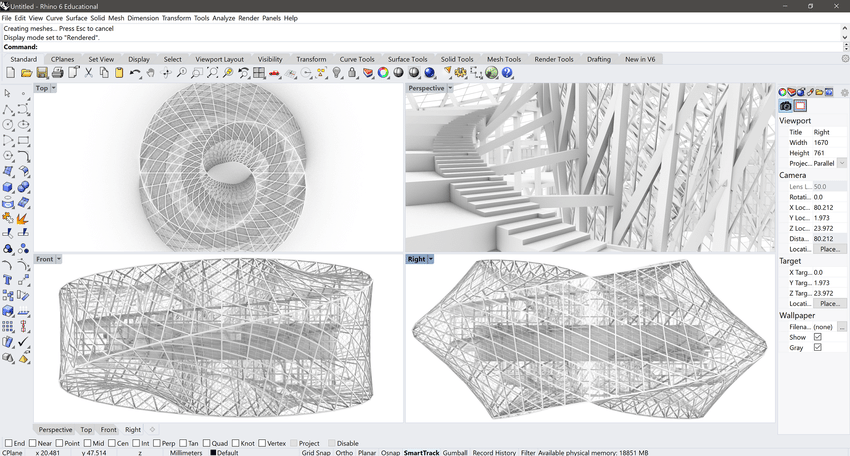Rhinoceros 3D sets the stage for this enthralling narrative, offering readers a glimpse into a story that is rich in detail and brimming with originality from the outset. It is a versatile and robust software that empowers users to create stunning 3D models across various industries.
Table of Contents
From architectural marvels to intricate jewelry designs, Rhinoceros 3D has become an indispensable tool for professionals and hobbyists alike. Its user-friendly interface and powerful modeling capabilities make it accessible to a wide range of individuals, regardless of their experience level.
Introduction to Rhinoceros 3D

Rhinoceros 3D, often referred to simply as Rhino, is a powerful and versatile 3D modeling software widely used in various industries. It is a NURBS-based modeling program, meaning it uses non-uniform rational B-splines to create and manipulate curves and surfaces. Rhino’s primary purpose is to provide a platform for creating, editing, and analyzing 3D models for a wide range of applications, including product design, industrial design, architecture, jewelry design, and more.
Rhino’s history can be traced back to 1980 when Robert McNeel & Associates (McNeel) began developing the software. The first version, released in 1990, was primarily used for surface modeling and quickly gained popularity for its intuitive interface and powerful capabilities. Since then, Rhino has undergone numerous updates and improvements, evolving into a comprehensive 3D modeling tool that caters to the diverse needs of professionals in various fields.
Target Audience for Rhinoceros 3D
Rhinoceros 3D is designed to cater to a wide range of users, including:
- Product Designers: Rhino’s precision modeling capabilities make it ideal for creating detailed product designs, from small consumer goods to complex machinery.
- Industrial Designers: Rhino’s ability to handle complex shapes and surfaces is crucial for creating innovative industrial designs, such as furniture, automotive parts, and consumer electronics.
- Architects: Architects use Rhino to model buildings, interiors, and landscapes, leveraging its advanced modeling tools for creating intricate details and complex geometries.
- Jewelry Designers: Rhino’s precise surface modeling capabilities are essential for creating intricate jewelry designs, including rings, necklaces, and earrings.
- Students and Educators: Rhino is widely used in educational institutions for teaching 3D modeling concepts and principles, providing a foundation for students to pursue careers in design and related fields.
- Hobbyists and Enthusiasts: Even individuals with no professional design background can utilize Rhino’s intuitive interface to create 3D models for personal projects, hobbies, and creative pursuits.
Modeling Techniques: Rhinoceros 3d

Rhinoceros 3D offers a comprehensive set of modeling techniques, empowering users to create intricate and complex designs. This section explores various techniques, emphasizing the foundational concept of surface modeling and its applications in design.
Surface Modeling
Surface modeling is a fundamental approach in Rhinoceros 3D, focusing on creating smooth, continuous surfaces. This technique is widely used in industrial design, architecture, and automotive engineering. The foundation of surface modeling lies in NURBS (Non-Uniform Rational B-Splines), a mathematical representation of curves and surfaces that allows for precise control and manipulation.
Creating Complex Shapes and Forms
Rhinoceros 3D leverages NURBS curves and surfaces to create complex shapes and forms. The process involves defining control points, which influence the shape of the curve or surface. By manipulating these control points, designers can achieve a wide range of geometric variations, from simple to intricate.
NURBS curves and surfaces provide a flexible and intuitive way to model complex shapes and forms.
Creating NURBS Curves
To create a NURBS curve, designers use a series of control points. Each control point influences the shape of the curve, and the degree of influence depends on its position and the curve’s degree. Higher-degree curves offer greater flexibility and control, while lower-degree curves result in smoother and more predictable shapes.
Creating NURBS Surfaces
NURBS surfaces are created by defining a network of control points that form a grid. Each control point influences the shape of the surface, allowing for the creation of complex and organic forms. The degree of the surface determines the level of smoothness and control.
Examples of Modeling Approaches
Rhinoceros 3D provides diverse modeling approaches, each with its own advantages and applications.
Subdivision Modeling
Subdivision modeling involves starting with a simple base mesh and then subdividing it into smaller faces. This process allows for the creation of organic and smooth surfaces, similar to sculpting clay. Subdivision modeling is particularly useful for creating realistic characters and organic shapes.
Polygonal Modeling
Polygonal modeling utilizes polygons, which are planar shapes with straight edges, to create 3D models. This approach is widely used in game development and animation, where efficiency and performance are crucial. Polygonal modeling offers a high degree of control over the geometry of the model, allowing for sharp edges and precise details.
Boolean Operations
Boolean operations involve combining different geometric objects using logical operations like union, intersection, and difference. This technique is essential for creating complex shapes by combining simpler forms. For example, a designer can use boolean operations to subtract a cylindrical hole from a rectangular block, creating a complex shape with a precise cavity.
Sweep Operations
Sweep operations involve extruding a profile along a path, creating a 3D object. This technique is commonly used for creating objects like pipes, bottles, and furniture legs. The profile can be a simple shape like a circle or a complex curve, and the path can be straight or curved.
Extrude Operations
Extrude operations involve extending a 2D shape along a specified direction, creating a 3D object. This technique is used for creating basic shapes like boxes, cylinders, and cones. The extruded object can be modified by adjusting the extrusion direction, length, and profile.
Loft Operations
Loft operations involve creating a smooth surface between two or more cross-sections. This technique is useful for creating complex shapes like car bodies, aircraft fuselages, and bottles. The cross-sections can be simple shapes like circles or complex curves, and the loft surface can be controlled by adjusting the shape and position of the cross-sections.
Learning Resources and Community

Learning Rhinoceros 3D effectively requires a combination of structured learning and active engagement with the community. This section will explore various resources available for mastering Rhinoceros 3D, highlighting the importance of the community in fostering knowledge sharing and support.
Online Tutorials and Courses
Online resources provide a flexible and accessible way to learn Rhinoceros 3D at your own pace. Numerous websites and platforms offer tutorials, courses, and learning materials specifically designed for Rhinoceros 3D users.
- McNeel Wiki: McNeel & Associates, the developers of Rhinoceros 3D, provide a comprehensive online resource known as the McNeel Wiki. This platform features a vast library of tutorials, documentation, and user guides covering various aspects of Rhinoceros 3D.
- YouTube Channels: YouTube hosts a wide range of Rhinoceros 3D tutorials created by individuals and organizations. These channels offer step-by-step instructions, project demonstrations, and tips and tricks for using the software.
- Online Learning Platforms: Platforms like Udemy, Skillshare, and Coursera offer structured courses on Rhinoceros 3D, often taught by industry professionals. These courses provide a more comprehensive learning experience, including assignments, projects, and instructor feedback.
The Importance of the Rhinoceros 3D Community
The Rhinoceros 3D community plays a vital role in supporting users and fostering knowledge sharing. Through online forums, social media groups, and other platforms, users can connect, exchange ideas, seek assistance, and share their expertise.
- Forums and Discussion Boards: Forums dedicated to Rhinoceros 3D provide a platform for users to ask questions, share solutions, and engage in discussions related to the software.
- Social Media Groups: Facebook, LinkedIn, and other social media platforms host groups specifically for Rhinoceros 3D users. These groups provide a space for users to connect, share projects, and engage in discussions.
- Online Communities: Websites and platforms like Rhino3D.com and Grasshopper3D.com offer forums, blogs, and resources specifically designed for Rhinoceros 3D users. These communities provide a central hub for knowledge sharing, collaboration, and support.
Conclusion
This comprehensive exploration of Rhinoceros 3D has unveiled its remarkable capabilities and its pivotal role in the design industry. From its intuitive interface and powerful modeling tools to its vast library of plugins and its vibrant community, Rhinoceros 3D empowers designers to bring their creative visions to life with unparalleled precision and flexibility.
The Impact of Rhinoceros 3D on the Design Industry
Rhinoceros 3D has become an indispensable tool for a diverse range of design professionals, from architects and industrial designers to jewelry makers and automotive engineers. Its ability to handle complex geometries and intricate details has revolutionized the design process, enabling the creation of innovative and groundbreaking designs. The software’s versatility and its compatibility with various design workflows have made it a cornerstone of the design industry, facilitating seamless collaboration and accelerating the design cycle.
The Future of Design with Rhinoceros 3D
As technology continues to evolve, Rhinoceros 3D is poised to play an even more significant role in shaping the future of design. The software’s integration with advanced technologies such as artificial intelligence, virtual reality, and additive manufacturing opens up exciting possibilities for designers. For example, AI-powered design tools can assist designers in exploring a wider range of design solutions, while VR environments can provide immersive experiences for visualizing and interacting with designs. The combination of Rhinoceros 3D’s powerful modeling capabilities with these emerging technologies will empower designers to push the boundaries of creativity and innovation, leading to the development of even more extraordinary designs.
Conclusion
In conclusion, Rhinoceros 3D stands as a testament to the power of innovative software solutions. Its ability to seamlessly blend advanced features with intuitive design principles has made it a cornerstone of the 3D modeling world. Whether you’re a seasoned professional or a curious beginner, Rhinoceros 3D offers an unparalleled journey into the realm of creative possibilities.
Rhinoceros 3D is a powerful software for 3D modeling, allowing you to create intricate designs and complex geometries. You might need to incorporate barcodes into your 3D models for various purposes, such as product identification or tracking. A free barcode generator can be a valuable tool for generating these barcodes, which can then be imported into your Rhinoceros 3D projects, adding a practical element to your designs.
